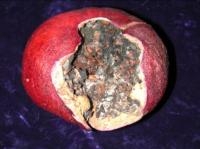Pomegranate (Punica granatum) is a specialty crop now grown on more than 10,000 acres in California. Pomegranate production has increased for both fresh market and juice in the last several years, and with this increase, random internally rotted fruit has become more noticed. The outside of the fruit looks perfectly fine, but internally the fruit is rotted and the arils (the flesh covered seeds that are eaten and juiced) are black. Pretty disgusting. Some fruit recently has shown up at harvest and the grower was unaware of the problem until the fruit was opened by a customer. The only difference between good fruit and affected fruit is that the blackhearted fruit is a bit lighter in weight. The absence of external symptoms makes the diagnosis of the disease very difficult, and consumers encountering the disease may change their perception of the pomegranate's many health benefits.
Initially, it was thought that the disease was caused by various fungi that can decay the arils. However work by Themis Michailides from UC Kearney REC has shown that after inoculation of pomegranate flowers and developing fruit that the main cause of black heart is Alternaria spp. These fungi are very abundant in nature and cause diseases in a multitude of crops. Another fungus that is also isolated from pomegranate with black heart is Aspergillus niger. However, the decay caused by A. niger is softer than that caused by Alternaria and results in exuded juice. In addition, another major difference between black heart caused by Alternaria spp. and that caused by Aspergillus is that the latter decays both arils and rind of fruit and frequently symptoms reach the outer surface of fruit, which helps in the diagnosis of the disease. Inoculations with Alternaria spp. reproduce the typical symptoms of black heart (internal decay of the arils without any external symptoms).
Inoculations periodically with Alternaria spp. showed that most of the infections occur at bloom time and that spores of the fungus that are introduced into the fruit (puncturing from thorns, hemipteran feeding like aphids and stink bugs, or cracking) can result in black heart. The current research focuses on the identification of the various species of Alternaria that cause black heart, the understanding of the infection process, and the development of procedures to manage the disease.
Alternaria alternata and related species commonly occur on plant surfaces and in dying or dead tissues of plants. The pathogens overwinter on plant debris in or on the soil and in mummified fruit. The spores are airborne and can be carried to the flowers with soil dust. Infections may also start from insect and bird punctures on fruit. Research in the San Joaquin Valley showed that the petal fall stage seems to be the most susceptible stage when most of the infection occurs. However, infection can occur throughout the long bloom and fruit development periods.
Estimated losses are usually less than 1% but can be up to 6%.
So how does a grower reduce black heart? Fungicide coverage has been a problem for bloom fungicides, but Michailides has shown some promising new materials. Good orchard management practices, such as dust control and sanitation (removal of old fruit and dead branches), may reduce the incidence of the disease. Infected, healthy-appearing fruit may be dropped to the ground by gently shaking the tree at the time of harvest. Avoid water stress and overwatering that may result in fruit cracking.
Thorough sorting and grading of pomegranates for discoloration and cracking can help avoid packing diseased fruit.
Attached Images:
